As a young boy, I picked up an attachment to video games very early. Starting out as the "Player 2" to my sister's "Player 1," I didn't have a console of my own until the release of the original PlayStation, and with it came a game I'd never heard of before: Final Fantasy IX. Before this, my gaming experience had been limited to platformers and Tetris. It didn't take long for me to become enraptured in the game's world, though there was one problem.
At that point in my youth, my reading comprehension was lackluster, to say the least. Whenever a dialogue-heavy scene would occur, I would have to call my mother in to help me read the text. For anyone who has even a passing knowledge of Final Fantasy, you can imagine how often this happened. It didn't take long before my mother got fed up and gave me an ultimatum:
"Learn to read, or give up the game."
It was quite a burden to put on my young shoulders, but I was determined to continue exploring Gaia. So, with as much gusto as a little kid can manage, I threw myself into my education, buying up chapter book after chapter book, spending my nights buried in homework, until I was reading at a high school level.
If it hadn't been for Final Fantasy IX, I literally wouldn't be the man I am today. I owe so much to this series, and what better way to repay that debt than to ring in Final Fantasy's 30th anniversary by replaying the mainline series? Starting at the very beginning, I plan on knocking out Final Fantasy I through XV before the end of this year. While I will be excluding XI and XIV for the sake of brevity, rest assured that every mainline Final Fantasy game will be discussed. My intention with these features is to take a look throughout the series, and to discuss the good, bad, and ugly parts of Final Fantasy. So, without further ado, let's start at the very beginning.
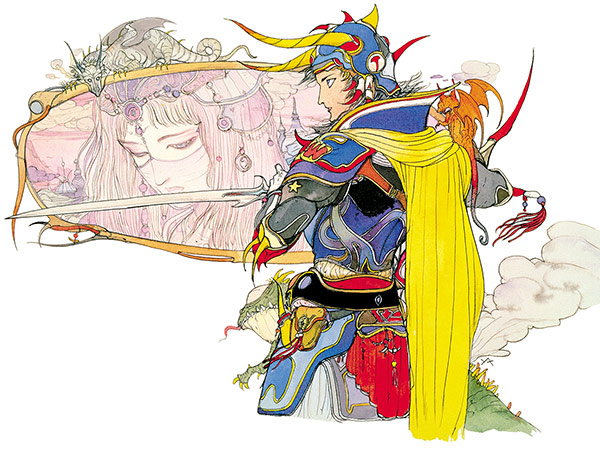
Warrior of Light by Yoshitaka Amano
While Final Fantasy IX was the first Final Fantasy I ever played, the Game Boy Advance port of Final Fantasy was the first game in the series I completed. Unfortunately, my old Game Boy is long gone, so for this playthrough, I went with the PSP version, which in my opinion, is probably the best version of the game currently available. While the original NES version was definitely a pioneer at the time, it is very dated by today's standards and its issues are notable. Certain stats simply didn't work in the game, and you had to be precise with your targeting. For example, if your Warrior and Thief were attacking the same enemy and the Thief killed said enemy before the Warrior attacked, the Warrior would simply do nothing when his turn came.
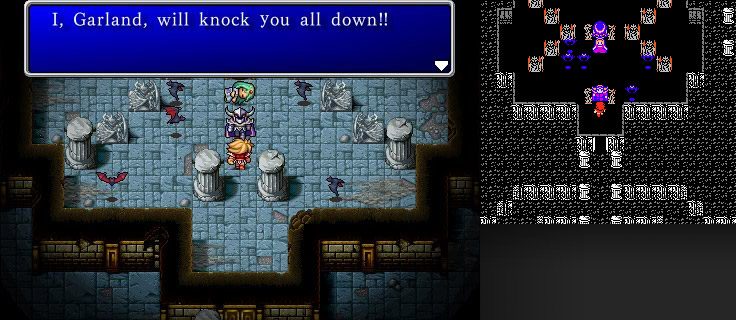
Final Fantasy Screenshots (iOS and Famicom)
For my playthrough, I ended up with a party consisting of a Warrior, Thief, White Mage, and Black Mage. It's a very solid party, especially when you complete the class change side quest, which allows the Warrior and Thief to cast white magic and black magic respectively. If you decide to pick up Final Fantasy, I highly suggest you only have two mages in your party, as magic can be extremely expensive. Which leads me to my next point, specifically the grinding required in the game. While it's possible to beat the game quickly, if you wish to be prepared and adequately leveled, you need to spend a few hours grinding. Magic and items become quite pricey around the middle of the game, and with a leveling system that tends to hand out stat boosts at random, it's essential that you take time to work on your party. I spent a good amount of time leveling around Elfheim, the third city you end up visiting, and I was pretty well off until the end of the game.
Story wise, Final Fantasy presents a pretty simple plot by today's standards, minus some confusing time travel and an inescapable time loop revealed towards the end of the game. However, the story does not easily present itself to the player. Like many older RPGs, Final Fantasy has very few cutscenes, requiring players to talk to NPCs found within towns to get a full grasp of what's going on and where to go next. I remember my first time playing through on the Game Boy Advance version; I tended to get lost very easily. It's a pretty straight shot from the beginning of the game to the Dark Elf fight, but once you have the ship and the world opens up, it's very hard to tell exactly where to go next. Sure, you have your basic mission: restore the four crystals of earth, wind, fire, and water. But figuring out where these crystals are can be time consuming.
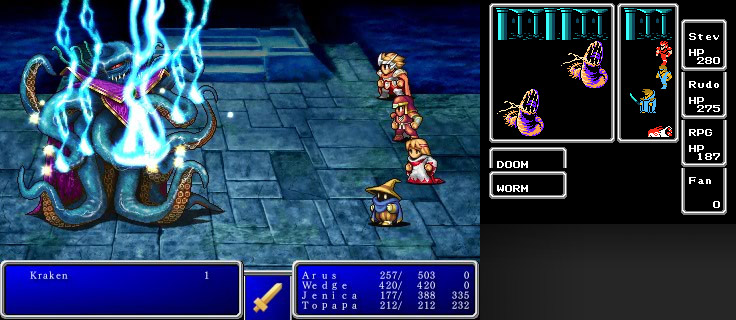
Final Fantasy Screenshots (iOS and Famicom)
Though it may sound like I'm quite negative towards the game, Final Fantasy established much of the groundwork that we still see in modern games. Many of the monster designs are unique and strange enough that they can still be seen in even the most recent Final Fantasy releases. We also see the beginning of the Black, White, and Red Mage, character designs that proved massively popular throughout the RPG community and beyond. Final Fantasy is like a grandparent. Yes, his stories might be dated and even a little boring, but when you know how much he's accomplished in his life, you can't help but respect him.
Would I recommend Final Fantasy to a modern audience? Absolutely. But don’t expect a mind-blowing experience akin to modern games. Instead, you should relax, sit back, and watch history unfold before your eyes.
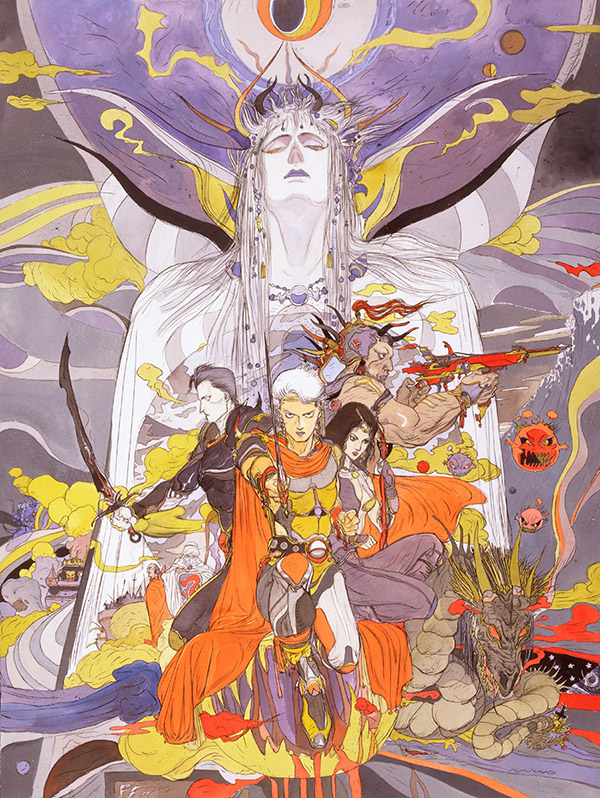
Final Fantasy II Cast by Yoshitaka Amano
Quest 64 was one of the only RPGs released on the Nintendo 64, and it was not a good game. The story was drab, the controls were abhorrent, and the grinding would push even the most patient of gamers to their limits. So why am I discussing Quest 64 in a Final Fantasy feature? Because I would rather play nothing but Quest 64 for the rest of my life than play another hour of Final Fantasy II. If you want a quick synopsis, I’ll keep it simple. Final Fantasy II is a bad game.
When I first started this journey, I thought that my biggest obstacles would be towards the later half, with the likes of FFVIII and FFXIII, which are generally considered low points in the series by most fans. Unfortunately, in my hubris to complete the early entries, I completely forgot about Final Fantasy II. To call Final Fantasy II a bad game is an understatement. It hits all the wrong notes for an RPG, and it plays like an elephant trying to do origami.
At the beginning, Final Fantasy II seems like a large improvement over its predecessor. The story starts off strong, with four newly orphaned children escaping the "evil empire," a trope that would become a staple in later entries in the series. In its defense, Final Fantasy II is responsible for many reoccurring elements in the Final Fantasy series. The Ultima spell makes its first appearance here, along with Chocobos and the original Cid. However, this is the only good thing I can say about this game.

Final Fantasy II Screenshots (iOS and Famicom)
To start, let's discuss the leveling system. Unlike every other Final Fantasy game, where characters level up after acquiring a certain amount of experience, Final Fantasy II functions similar to the Romancing SaGa games. For example, if you want a character to be a strong sword fighter, you have to make sure the character battles using mostly swords. I'll admit, this doesn't sound too bad on paper, but the other stats are where this system falls short. The only way to increase a character's HP is to take damage and end the battle in a wounded state. So if you want your party to survive against even a gentle breeze, you must be constantly damaged. And if you want to build a capable healer, you have to use healing spells on these wounded characters. But if a character is at full health, then they have no chance of increasing their HP. I hope you can see how truly backwards this system is. Most players spend the first few hours simply attacking their own party members to increase their skills. In turn, this can make Final Fantasy II either the hardest or easiest game in the series. Those who are new to the game more often than not experience plenty of party wipes, while experienced players tend to overlevel and rush through the game easily.
If you are worried that rushing through the game will hinder your experience, I promise you, you aren't missing much. The story is lifeless, even when compared to other NES-era RPGs. The main characters are dull as bricks, while the temporary party members, who actually have rather decent backstories, get killed off at such a rapid rate that it almost becomes humorous towards the end of the game. And even these temporary party members function exactly the same as the main party, so when they do join up with the main characters, you're practically forced to spend hours leveling them up to an adequate point. Grinding, thy name is Final Fantasy II.
Honestly, it surprises me that the Final Fantasy series managed to survive past this entry. Final Fantasy II was before my time, so admittedly, I can't speak on how the game felt when it was first released. But compared to later entries in the series, II is really the lowest point. Fortunately for me, it's all uphill from here.
Long story short: please don't play Final Fantasy II. Your sanity will thank me.
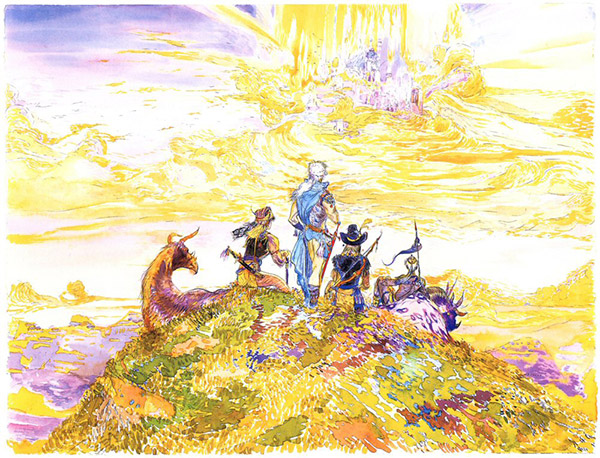
Final Fantasy III Cast by Yoshitaka Amano
I was really excited to play Final Fantasy III, as it was the only Final Fantasy I'd never touched. Before working on this feature, I had dabbled in most Final Fantasy entries, even completing a few back in the day. But Final Fantasy III had eluded me for all my life. I think this mostly had to do with the fact that gamers in the west didn't have the chance to experience it until the DS release in 2006. At the time, I was going through school, so my gaming hours were sorely taken up by school work and being an angsty teenager. So how does Final Fantasy III fare in this day and age?
Starting out, I noticed that Final Fantasy III has a rather high initial difficulty. It took roughly an hour for all four player characters to join the party, and even then, there was a bit of time before I had access to the job system. But this little hitch goes away very quickly once the meat of the game is introduced. For those unfamiliar with the Final Fantasy series, Final Fantasy III was the first game to introduce the job system. While Final Fantasy I did have character classes, once you picked your team at the beginning of the game, you were stuck in those roles. With FFIII, however, players are able to freely change jobs on the fly to suit their needs and create the ultimate party. The system did need some refining, which we'll see in Final Fantasy V, but hey, it's a start!
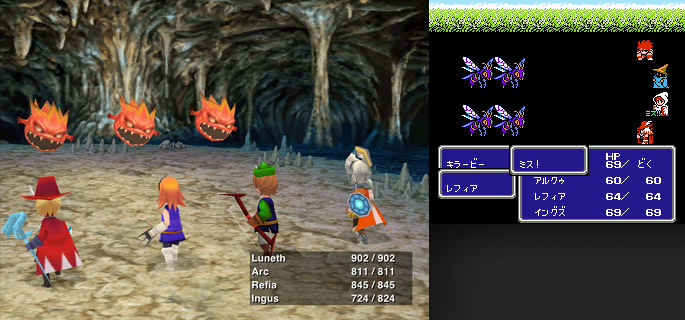
Final Fantasy III Screenshots (iOS and Famicom)
My process for games that involve changing jobs is to constantly and obsessively make sure the classes are equally leveled. This turned out fantastic for me, but for those who would prefer to stick to only a few classes, this can potentially lead to disaster. For example, near the beginning of the game, the party must be under the Mini status ailment in order to proceed. This means that, for this particular dungeon, physical attacks are completely worthless; you need a full party of magic casters. My only gripe with this scenario is that there's no advance warning for players. If you want to play through Final Fantasy III, you're going to have to grind. A lot. And God help you if you aren't prepared for the final dungeon. The Crystal Tower is a gauntlet of bosses, with practically no breaks in between, and no chance for players to catch their breath, as the regular enemies are no laughing matter as well. Pray that your healers stay alive, and maybe you'll get to see the ending. Scholars and Ninjas are your friend!
Grinding aside, Final Fantasy III is a very enjoyable experience. The story is perfectly up to par, though I can't really speak for the original NES version. For those unaware, the DS version of Final Fantasy III contains more than just pretty graphics and quality of life changes. While the main party in the original NES version were essentially blank slates, the DS version features a fully fleshed out party, with intricate backstories and quirks. I feel like this really gives a leg up to the DS version, especially if you prefer your games to be story heavy.

Final Fantasy III Screenshots (iOS and Famicom)
Now, let me discuss the biggest problem for anyone currently playing the DS version. Final Fantasy III has a mailing side quest that relies heavily on the Nintendo Wi-Fi Connection. This service allowed DS owners to access DLC and online services for games, similar to what we see now in modern consoles. The service, however, was discontinued in 2014. This scenario wouldn't be such a big deal if it didn't affect the base game. Unfortunately, some endgame content in Final Fantasy III requires this service. Players are no longer able to access the post-game dungeon or acquire the ultimate class, the Onion Knight. I admit, this may not be important to some, but for a completionist like me, it's a big letdown.
Out of the original three entries, I feel that Final Fantasy III is the strongest. Building on the original gameplay of Final Fantasy I, while simultaneously destroying almost everything from Final Fantasy II, this entry is a solid experience, with a story that still has legs even to this day. If you're like me and missed it when it released, do yourself a favor, and pick up a copy of Final Fantasy III.
< Return to Feature Hub







